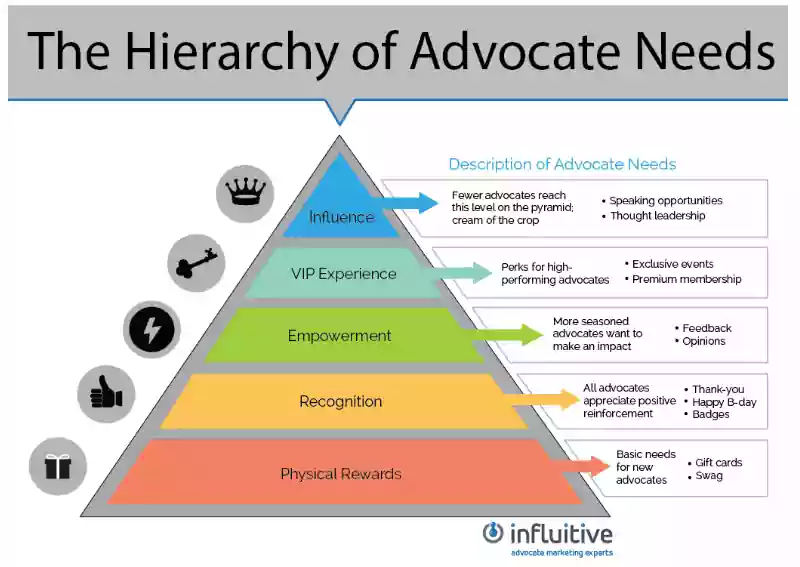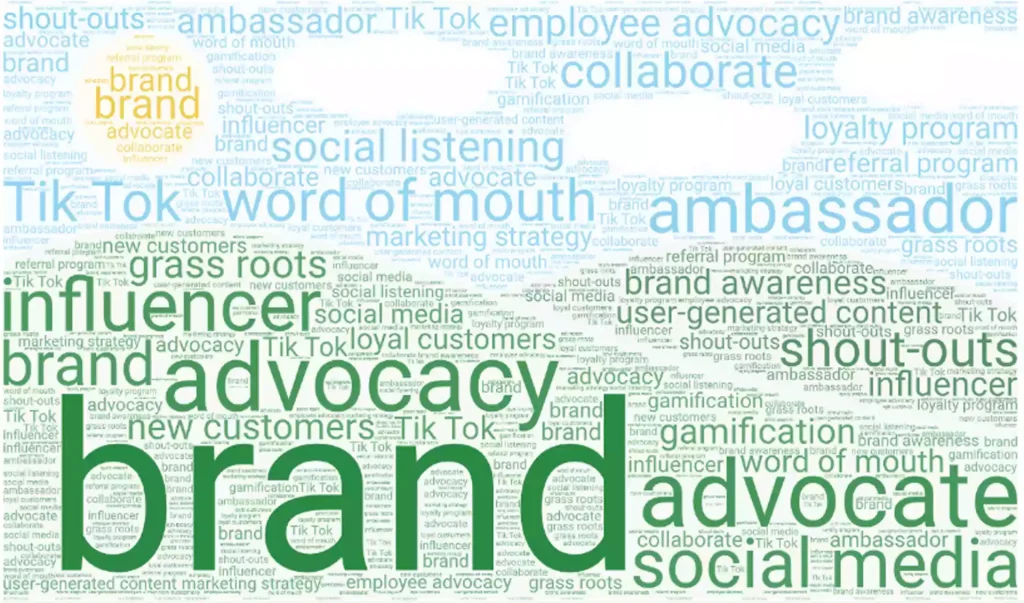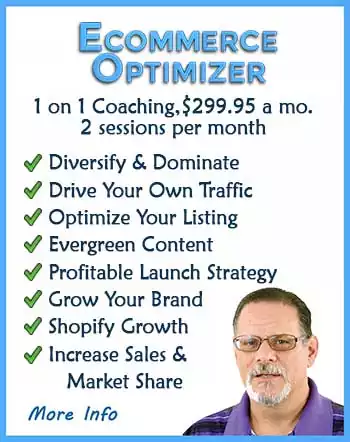What Is A Brand Advocate?
A brand advocate is a loyal customer who advocates for your company through content creation and recommendations to friends, family, and others on the different online platforms and in person. Their positive words help build your brand’s reputation, promote your business, and create new buyers.
Many new sellers consider branding and successful social media as simple as setting up social media accounts. They get caught up in the standard methods, which rely on expensive paid ads and PPC.
Facebook Ads no longer have the reach they once had, but they cost more. Privacy laws have obliterated the ability to hard target specific audiences. High-paid influencers have lost our trust.
Consumers have become very leery of brands; 69% of US consumers do not trust advertisements.
Consumers have made themselves clear; 92% of them believe the recommendation of a stranger over the statements of a brand. Using brand advocates can help you achieve a broader reach and connect with a larger audience.
Savvy marketers have long known that their customers and their loyal followers can help build their brand. Encourage your fans to not only ‘like’ and ‘follow’ but to post their content on theirs and your pages. You want to turn customers into fanatics, raving fans advocating for your company.
Social media advocacy is about one thing, encouraging people to talk about your products. It won't work, obviously, unless you have a social media presence where you routinely share information and build emotional connections with your community members.
People trust people. Over 80% of consumers research products before deciding to purchase online. When they see ordinary people talking about how much they love a product and what it has done for them, they notice.
For example, Apple has brand advocates worldwide, accomplishing this through fantastic customer experiences and great products.
It’s great when customers give you a boost by talking positively about you and your business. According to the BrightLocal platform, 88% of people trust 3rd party online review platforms and recommendations from friends and family. This means that a loyal audience that tells others positively affects the brand’s reputation.
What Are The Benefits of Building An Advocate Program?
People trust other people more than brands, so why not let your customers do some of the marketing for you?
How Do I Start A Brand Advocacy Program?
Social selling has become an essential part of marketing campaigns. Word of mouth marketing, coming from happy customers telling others across social networks, is necessary for a solid brand advocacy strategy.
But what do you need to do to put this advertising method in place?
Establish goals for your advocacy program that align overall with your marketing strategies.
Create a memorable brand with exceptional products and customer experiences that people would want to tell others about. Involve your entire organization, making it a part of your company culture. Employee advocates can be more effective than brand advocates in many cases.
Create great content, referral programs, loyalty programs, a feedback process, and encourage UGC (user-generated content). Give them plenty to talk about, create a positive experience, and even create a sense of community with your group.
What Is The Difference Between An Influencer And An Advocate?
A social media influencer is different from a brand advocate because of the follower relationship and their role in the brand.
An influencer is a person who can sway people’s purchasing decisions. Influencers usually partner with brands for free products and other rewards in exchange for posting about their products or services on social media.
On the other hand, brand advocates are loyal fans who have a strong emotional attachment to the brand and have a longer-term relationship. They are not limited to specific promotional campaigns. Brand advocates are genuine fans of the brand and love it enough to promote it.
Influencers may or may not like the product but are willing to promote it for compensation and use their followings to earn a living. Since they don’t have an emotional connection with the brand, their feedback can be less reliable.
Brand advocates have a more loyal following that brands can count on for credibility and revenue. Influencers and advocates sway the opinions of their followers. With advocates, you will be building long-term ongoing relationships with them.
How Do I Know If An Influencer Would Be A Good Advocate?
What if we could them into brand advocates? What if we could create that ongoing advocate relationship with them? Not all influencers make good advocates, but the newer, smaller ones may be able to be flipped into becoming an advocate..
Listed below are some of the criteria that you should use when evaluating which influencers might make good advocates:
What Methods Should I Use To Turn Influencers Into Brand Advocates?
Taking them to the advocate level will mean additional involvement and effort from you both to extend the relationship. Try the methods below to see if they are willing to make an effort.
Invite them to take over your social profile for a day - This builds trust going both ways and requires them to lean in on their following for better results.
Collaborate with them to create exclusive content - Exclusive content and limited edition products generate leads and create additional content opportunities. Working together builds trust through mutual respect.
Pay for performance - Add them to an affiliate program and pay them when items sell due to their efforts. If they are motivated, create goals and bonuses.
Communication - Communicate with them regularly and nurture the relationship.
How Do I Identify Potential Brand Advocates?
Laura Ramos from Forrester Research broke down the different types into four different advocate personas. She suggests a best practice of evaluating your potential advocates, understanding what each wants, and using that information to better reward and motivate them. She states that by giving them exactly what they want, "customer goodwill becomes gold".
The four advocate personas are

(Source)
The more you can personalize the experience for the advocates, the closer they will feel to your brand. As you will see in the tools section, there are platforms that you can use to evaluate your lists and manage your program.
Using Online Tools To Identify Potential Advocates
There are software platforms available such as Influencer Bit, a tool that incentivizes, tracks & rewards your loyal customers to mention you on Instagram! There are many other different online tools and platforms available as well. See our list of influencer marketing tools.
Set Up Social Listening To Identify Potential Advocates On An Ongoing Basis
You can identify your most loyal customers by monitoring social media and collecting brand mentions that contain positive keywords.
Appreciating a brand or product is the first step to becoming an advocate. You can automate social listening by setting up free Talkwalker Alerts.
Kickstart The Process By Identifying Potential Advocates Manually
The best place to look for potential advocates is your existing followers' list and buyer database.
- 1Go through the social media profiles of your most engaged fans and buyers. On average, up to half of a brand’s customer base are advocates (70-80% for B2C and 30-40% for B2B).
- 2Check their metrics using a tool like Socialblade (you want people with 500+ followers, preferably at least a 2.5% engagement rate).
- 3Wash, rinse & repeat the process until you have found potential advocates you like. The size of the list that you start with will determine how many names you collect. Your goal is 50. You may be starting with too small of a list. If this is the case, shoot for 15 to 30 this time.
- 4Once you have a list of potential advocates who align with your target audience, you will need to perform outreach. You now have two options. A.) Email them direct, mention that you appreciate their participation and contribution to your social account, and ask if they would be interested in helping out more. Be prepared to send them another unit, so they have a fresh one for the picture. B.) You will have mailing addresses for previous buyers. Some people like to send the product without emailing them first. Aim to ship your product to 15 - 30 of them.
- 5When they receive the product, slide into their DM’s and request a feed post and a series of 2-5 stories in return + a review on your (website, Yelp, Google Maps, Trust Pilot, Amazon, etc..) if they love the product. Each of these, besides Amazon, will create a separate brand page with your reviews. These will rank separately on Google. When someone searches for your brand +review, the more different positive review profiles that fill the SERPs, the better. Use this to your advantage. Give them a custom link and a discount code for their followers.
- 6If they agree and their audience converts well, repeat the collaboration a couple of months later with extra incentives.
Rewarding your Brand Advocates For UGC
After establishing relationships with brand advocates, give them early access and sneak peeks at new products and business updates, when they talk about your company, talk about them right back and engage on their posts too. Share their reviews and comments on your website and across your social media accounts. Do your share of the legwork because you are business partners. Word of mouth advertising is the best form of advertising and can add a lot of market value to your business overall.
With advocates, if possible, don’t try to turn it into a pay per transaction relationship. Create a list of things that they can repeatedly do at different times. Take your list and assign a certain number of points that they can earn. Chose some gift card amounts that they can redeem the points earned to receive. Set the number of points required for the first gift card high enough, so they have to do 3 or 4 things for you. There are many different ways to motivate your advocates.
You want to make this a positive experience for them. You can create a buyer referral program and make them the spokesperson for the program. Another possible method is to add a level of gamification where each month you post missions for your advocates to complete.
Brand Advocacy Campaign Examples
The more you know about brand advocacy, the more strategies you’ll discover for getting people to talk about your company or your products and services. People are most likely to advocate for a brand when they like the company or love the products and services.
For example, Apple fans (7.5 million followers)will defend their brand. They often talk about how much they love their latest iPhone or laptop. Apple fans are among the most loyal globally, rarely switching to other well-known businesses. They are also vehemently defending the brand’s perceived advantages and disadvantages. How cool would it be if your company had that many people advocating for it?
Starbucks is devoted to encouraging customers and employees to promote the brand to their friends by posting about their experiences. Look at the coffee chain’s 18 million-follower Instagram account, and their efforts are apparent. People actively tag Starbucks as they post pictures of their beverages and food. At any one moment, they have several different social media campaigns running.
They take it further by incentivizing employees to become brand advocates and ambassadors. They have launched a variety of different programs, such as heritage month. During this month, baristas wear traditional costumes from their home countries and share their histories and traditions with customers in the store and on social media. Telling the stories of their employees shows that the company cares about its audience’s values.

Starbucks also has a program that started as Tweet Your Coffee and has since expanded to other platforms. There are many thousands of likes for each, but the engagement of 523, 812, and 615 comments in 3 weeks is fantastic. I was scrolling back four months ago to the holiday season, the one I looked at has 162k likes plus 1771 comments. Those are incredible numbers.
Use Advocacy Marketing To Turn Haters Into Raving Fans
Turning haters into social media advocates can be challenging at first, but it happens more often than you may think. It’s easier to find users who love the brand, encourage them, and get positive feedback. However, many companies know that their most vocal supporters started as unhappy customers.
When someone has an issue with your product, and they are very vocal about it, what are they seeking? More often than not, they want to be heard, acknowledged, and shown some empathy. Hear them out and eliminate the cause of the outrage. Showing them their opinion does matter. Many times that personal connection leads to them becoming your most vocal advocates. Far fewer are after their money back than you would think.
Advocates will routinely defend your reputation because they believe in a brand. Offset blatantly incorrect negative reviews by asking advocates to produce content that demonstrates the truth. That content can at times keep complaints from even occurring in the first place.
For years, McDonald’s was targeted for not offering a vegan menu. People went so far as to try to organize boycotts. After years of refusing, they finally launched a vegan menu. Those same consumers went nuts over the new items, and support for McDonald’s exploded. Their menu went viral on social media overnight.
Don't Ignore The Voice Of Your Audience
Companies have set algorithms, templates, and guidelines indicating which response to send when they leave negative feedback. Engaging with the users and responding to negative comments and positive comments is critical for fostering advocates. Maintaining an open dialogue encourages more reviews.
Naturally, the right social networks will play a key role in your brand advocacy program’s success. Social media is an ideal platform where business owners can interact and build relationships with potential buyers. Identify which platforms your target market uses most often so you can get involved in the proper discussions.
Be open to hearing customers’ positive and negative things about your brand. It can be challenging for brands to address their customers’ concerns. Brands that address concerns quickly can transform unhappy clients into brand advocates. Customer experience is essential, and it does not end at the sale.
Answer all reviews, positive and negative. Answering a review is positive reinforcement and makes the writer feel their opinion matters. Use keyword phrases in your answers naturally to optimize for search to maximize the value of the review. Amazon sellers should answer every question posted on their product page and include a keyword phrase or two to aid SEO. Google indexes everything on the page.
In 2010, Coca-Cola deployed a “Happiness Machine” on a university campus to generate excitement and brand advocacy. Each time the Happiness Machine dispensed a soft drink, it was recorded with a video camera. The machine invited passersby to share their happiness on social media, which then helped Coca-Cola spread the word about its product.
The “Happiness Machine” campaign was only featured on one campus. Still, the virality, abundance, and engagement that it created made it very popular on social media. This video has over 11 million views from loyal customers.

To kick off its brand advocacy program, Urban Outfitters created its platform for both employee advocacy and brand advocates. It curated all of the different posts and mentioned relevant to the brand and its’ products on Instagram.
Humans crave security and feeling like they belong. This carries over to brand loyalty when they are confident in the quality and consistency of a brand. We also tend to tell those around us about the things that excite us. People do not like change in general, so they are more apt to stick with a brand than try something new as long as they are happy. Cross that line and do not expect that loyalty to remain.
Another piece of compelling research confirms that personal recommendations are among the most effective motivators to purchase particular goods. 88% of individuals would be more likely to trust a brand if a friend or family member advised it. At the same time, if any of their friends or relatives had a bad experience with a brand, 26% of customers would avoid it on purpose.

TOMS is a shoe company that plays to the giving nature in all of us with the company’s slogan: one to one. For every sale made, they donate one product or service to underserved areas around the world. The company easily creates loyal buyers out of first-time customers by staying connected with these acts of service. You can see on their website that they are focused on service and giving back to their communities. The goodwill drives a ton of free press, which helps SEO and translates into ranking and sales.
TOMS also has a fairly strong ongoing advocacy initiative. They drive traffic to their store by encouraging customers to participate in their social media campaign #withoutshoes which drives user-generated content and word-of-mouth advertising.
Leesa sells mattresses. Anyone in that market will tell you that it is very competitive. Rather than compete with the big box brands, they use word-of-mouth advertising by using Referral Candy, a platform for driving referral sales from existing buyers. They are also deeply connected to their community and service, donating one mattress for every ten that they sell and have a popular brand advocacy platform too.
There are many different social media advocacy campaign examples around the internet that can be used as examples. As you've seen, It can be as simple as a loyalty program and as in-depth as an entire legion of people competing by posting and spreading the word. While anything is better than nothing, the best path forward is to use multiple methods building one out at a time, The key to a successful advocacy effort is to try. You have to start somewhere, why not now? It is still early enough in the year to have this in place and add to your business in time for Q4.
Choose Brand Advocacy Marketing for the win
Your brand advocacy strategy is important to your overall digital marketing strategy for your business. Encouraging customer advocates and employee advocates to talk about your products online increase the reach, reputation, touchpoints, ugc, brand awareness, customer base, brand loyalty, and a whole host of other benefits. Whether you are using referral programs, blog posts, loyalty programs, or other rewards and bonuses, whatever you do to increase the buzz about your brand and products are going to help.
There is a famous Harvard Business Review study that found that just a 5% increase in customer retention can increase profits from 25 to 95%. Do you see how advocacy marketing can benefit your brand long term?
Remember, the bottom line of any brand advocacy program is getting new and current customers to talk about your product or service. Their help can turn potential customers into future loyal customers. It can be a very powerful tool to reach potential customers at that critical awareness stage of the buyers' journey as well as add to your ability to gain new supporters. Armed with voracious content and the ability to leverage your fan base, you can engage potential customers and rekindle the loyalty of existing ones.
Make the most of your social media marketing and public relations budget by encouraging your users to create and share content. Follow the best practices and advice in this article. Your business will be stronger, and it will positively impact your sales. We have an entire series of articles about working with influencers, brand ambassadors and brand advocates that includes different strategies, tools and techniques starting with the Influencer Marketing Guide.



